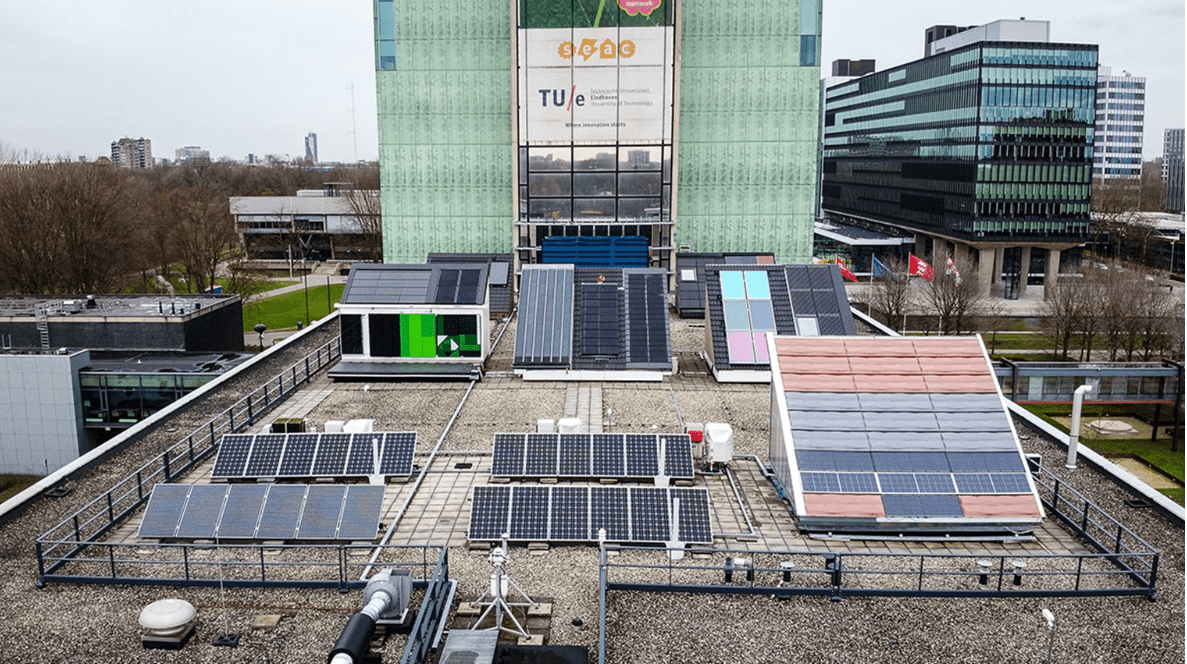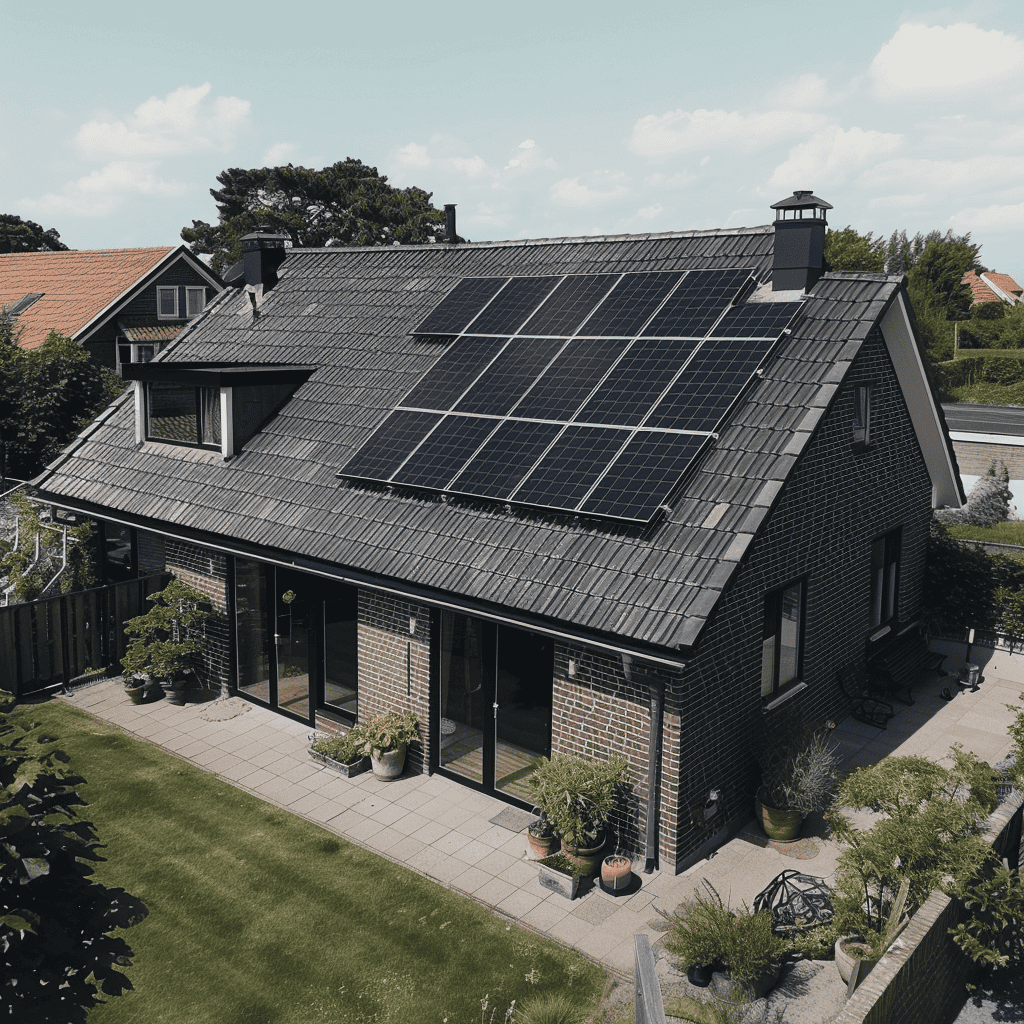
In 2022, the capacity of solar panels on Dutch rooftops grew by thirty percent. A “historic growth,” according to the industry association Netbeheer Nederland. Good news because the climate-neutral Netherlands in 2050 is getting closer.
But this enormous growth also raises questions, the main one being the power grid’s capacity. Because at times, when the sun shines, plenty of energy is produced, but households often use less power. So a lot of power is then supplied to the grid. So it happens that solar panels are (temporarily) switched off because the electricity cannot be processed. And then there is the aesthetic aspect: do we want black panels on all our buildings?
A colorful collection of solar systems

The integration of solar panels in, on, and on buildings that consume energy directly can solve the above issues, believe at the research center SolarBEAT. Therefore, since 2014, a colorful collection of solar systems adorns the roof of the Vertigo building on the TU/e campus. Think solar windows, solar facades, PV balcony fences, or solar roof tiles.
SolarBEAT is a TNO and TU/e facility for building-integrated solar energy systems where companies, scientists, and other agencies test their innovations throughout the year. There is room for fifteen systems; on average, about eight ongoing projects are tested simultaneously.
“The energy transition needs space, and perhaps no other European country where space is as limited as the Netherlands. So we do need to integrate solar panels into our buildings. This is a necessity, but it also makes us leaders. We are forced here to play crazy tricks with our buildings (laughs) if we want to meet the climate goals. That’s what makes my job so interesting,” says solar energy expert Roland Valckenborg. He is the project manager at SolarBEAT (Solar Building Elements Application Testing).
The facility supports developing, testing, and monitoring innovative solar panels and solar thermal collectors. The outdoor laboratory has more than a thousand sensors that measure how systems perform and is one of Europe’s most extensive testing facilities within its category. Valckenborg: “For example, one company wants to know how much solar energy their panels produce at low solar irradiation, another wants to know if their roof is still waterproof when they put solar panels on it. In an ideal scenario, a project runs for an entire year, so you catch all seasons and conditions once.”

Panels in all colors (and shapes) of the rainbow
Aesthetic objections to a country full of black solar panels are being addressed in full force at the test facility. Five years ago, for example, a red solar panel was quite something; now, you can order solar panels – like paint at the hardware store – by color code. “The technology is now so advanced that the difference between the yield of light and dark panels is very small,” Valckenborg says.
There is also increasing freedom of form. Technology has become lighter, thinner, and smaller. At SolarBEAT, there is plenty of experimentation with different shapes. “This does not necessarily provide the most kilowatt hours, but it is also important to keep the building looking aesthetically pleasing. Our mission is to show that a lot is possible in making buildings energy neutral. We show that on location during tours but also want to convey that message in public places.”
Storage
Significant problems are anticipated in terms of grid capacity; something SolarBEAT is also working on. Valckenborg: “We are doing research with multiple storage systems. That could be a battery for electrical storage or buffer vessels for thermal storage that relieve the load on the grid.”
One of the projects that will install its system next summer is Cellcius. This TU/e and TNO spin-off is developing a salt battery where households can store wind and solar energy. Within SolarBEAT’s infrastructure, the company will test the battery within a total system. “We simulate a household of four people who, for example, get up at seven in the morning, shower, go to work and school, and return home in the evening. We measure the temperature of the dummy house, the power consumption, and the heat flows. This allows Cellcius to optimize and prepare the product for the market.”
Spin-outs
For Cellcius, that will take some time, but Solarge‘s lightweight solar panels are now ready to be sold after four years of testing. Whereas not all roofs can support regular panels, Solarge’s solar panels suit all roofs. At SolarBEAT, the company researched the structural requirements for the lightweight board. They also optimized the yield by testing several variants of the PV cells. They will open their factory in a few months.
Also on the roof of the Vertigo building is a small house with green facade panels from Calosol and a heat pump. The facade panels are solar collectors that can be executed in any color and with patterns. During the day, when the sun shines, the panels act as classic solar collectors that heat water. At night and during the day when the sun is not shining, the panels support the heat pump – which can thus run at a much higher efficiency. “The investigation of these total solar energy systems, i.e. heat pumps, storage, and solar panels and collectors, will become increasingly important in the coming years,” Valckenborg said.
Another development being tested at the laboratory is energy generation through solar windows. Now the panels are still visible in stripes, but Pilkington is investigating at SolarBEAT whether this can also be done invisibly.
To measure is to know
The Eindhoven outdoor laboratory has state-of-the-art equipment for testing all conceivable scenarios. Valckenborg: “On request, we can measure everything. Is a panel flapping in the wind? What is the temperature inside the system? What is the yield at diffuse solar radiation? How can the yield of a heat pump be significantly improved by building a smart system with solar collectors? And so on.”
In addition to professional measurement equipment, SolarBEAT has a decade of expertise in the field of building-integrated solar energy. “That expertise is crucial for the energy transition worldwide. The question is not whether building-integrated solar energy is needed, but how many different solar energy systems will come on the market in the coming decades to suit a specific building market segment. That will be hundreds of different systems rather than dozens,” Valckenborg concludes.








